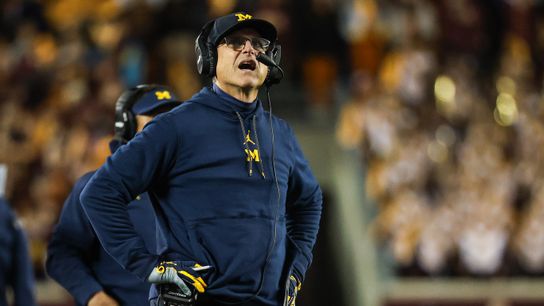The Big Ten is weeks away from finalizing a set of contracts that will pay the conference upwards of $1 billion a year. With USC and UCLA coming aboard, the conference will distribute $100 million per school per year at some point over the life of the contracts. Actually, that was the expectation before USC and UCLA joined the party.
And so the natural follow-up question is to ask what to do with the money.
Do you pay your running backs coach $2 million a year? Build a weight room just for your offensive line?
No, no one is asking those questions. The most common question on people's lips: Is it time to cut players in on the action?
That's the question Penn State quarterback Sean Clifford has asked Big Ten commissioner Kevin Warren. And it's a question Jim Harbaugh is prepared to answer, and he's prepared to answer it with a yes.
“You know me, I’ve always been for NIL,” Harbaugh said. “I believe players should have a share in the revenues, and I think that’s something that’s really possible at Michigan. I think that’s where we’re headed.”
Asked to clarify how he sees that working in practice, Harbaugh suggested the conference sign each of its players to an NIL deal.
“They use their name, image and likeness on the TV broadcasts,” Harbaugh said. “They’re the ones signing the mega-TV deals. And a new one’s coming in 2024. Why can’t that be an NIL deal right from the Big Ten?
“Because that’s who’s negotiating the TV deals, and that’s where the big money is.”
In practice, I'm not sure the difference between a conference-wide NIL deal and a professional salary, but I'm also not sure it matters. Either way, Big Ten coaches would be smart to embrace Harbaugh's idea.
In theory, a conference-wide Name, Image and Likeness agreement would pay every Big Ten athlete the same. If that were the case, every Big Ten player would be on equal ground with his teammates (players could still garner outside NIL deals, as they do now), every Big Ten coach would be on equal ground with his colleagues/competitors in the conference, but the 16 of them would be at a significant advantage over their competitors from other leagues. Sure, if the Big Ten were to formally fork over a slice of the pie, the SEC would likely follow suit, but not every other conference would. And even still, the Big Ten would forever retain the title as the first league to formally share revenue with its players.
Merely discussing this idea is unfathomable for many in college athletics. The former Big Ten commissioner is among that group; Jim Delany infamously (and hilariously) threatened to move the Big Ten to Division III if college athletics ever ditched the amateur model.
But the current Big Ten commissioner spent this week telling the public he's happy to be the one doing the ditching.
"Because where we are right now, I'm focused on being realistic about the state of college athletics, about accepting our responsibility to shape college athletics, lead college athletics, fortify college athletics, to be bold, to be strong, to be innovative," Kevin Warren said. "I want to make decisions that, when we look back 30 years from now, that people will say that the Big Ten Conference was ahead of the curve in making these decisions. That's what I think about every day."
